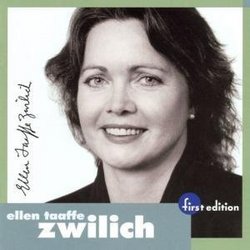| All Artists: Ellen Taaffe Zwilich, Albert-George Schram, Lawrence Leighton Smith, Louisville Orchestra Title: Ellen Taaffe Zwilich: Chamber Symphony / Concerto for Violin, Cello and Orchestra / Symphony No. 2 Members Wishing: 0 Total Copies: 0 Label: First Edition Release Date: 4/13/2004 Genre: Classical Styles: Chamber Music, Forms & Genres, Concertos, Historical Periods, Classical (c.1770-1830), Modern, 20th, & 21st Century, Symphonies Number of Discs: 1 SwapaCD Credits: 1 UPCs: 809157000044, 080915700004 |
Search - Ellen Taaffe Zwilich, Albert-George Schram, Lawrence Leighton Smith :: Ellen Taaffe Zwilich: Chamber Symphony / Concerto for Violin, Cello and Orchestra / Symphony No. 2
 | Ellen Taaffe Zwilich, Albert-George Schram, Lawrence Leighton Smith Ellen Taaffe Zwilich: Chamber Symphony / Concerto for Violin, Cello and Orchestra / Symphony No. 2 Genre: Classical |
Larger Image |
CD Details |
CD ReviewsFour Stars gavin | Denver, CO United States | 12/30/2007 (4 out of 5 stars) "This disk not only features Ms. Zwilich's Second Symphony, it contains her Chamber Concerto and a Double Concerto for Violin and Cello. That's a lot of string works! The Chamber Concerto is not quite in the mold of the famed concerti for chamber groups by Arnold Schoenberg, using a larger group and a conventional chamber orchestra string section (Schoenberg and those who followed his example used one musician per part only, not multiple string players). The other two works use fairly unremarkable forces: the modern full orchestra, with some featured soloists. Sadly, as we usually find with contemporary composers, the orchestra performing on this disk is not a top-notch group: The Louisville Orchestra. They may not be the Boston Symphony Orchestra, but they are well-rehearsed and up to the task. The main drawback is that the string and wind sections lack the polished sound that comes from polished intonation and better-quality instruments; the unity and precision of a top orchestra also allows for more powerful accents and fortissimos. The works rely on fairly standard language, a good illustration of Ms. Zwilich's approach. While complex, she doesn't use vast bunches of chaotic cross-rhythms and super-abstract rhythmic and harmonic concepts. Instead, she relies on melodies, but eschews the simplified harmonies favored by some more-tuneful composers and displays her signature string sound at times in the Double Concerto and Symphony: dry, atmospheric and spare. Ms. Zwilich also manages soloists and orchestras extremely well, allowing the featured instruments to change their relative sonic positions in relation to the larger group: now hidden, now interwoven, now standing in the foreground. Meanwhile, the chamber work shows her ability to manipulate smaller forces in a handful of interesting ways--again, with interesting harmonies and tunes. She's a darned good composer and this recording is as good as any I've heard from her." A good introduction to the music of Ellen Taffee Zwilich and Discophage | France | 01/10/2008 (5 out of 5 stars) "The Chamber Symphony, the earliest composition on this disc (1979), is scored for six players (violin, viola, cello, flute, clarinet and piano) and, an exception in the usual First Edition Music policy, this recording from 1992 makes here its first appearance on disc I believe. The music is slow-moving, terse, ritualistic, despaired. It was written "not long after the sudden death" of the composer's husband, violinist Joseph Zwilich.
The Double Concerto for Violin and Cello from 1991, a Louisville commission and premiere recording, is full of subtle and delicate dialoguing filigree between both instruments, but also of passionately lyrical statements. Sonorities typical of Tippett (Triple Concerto) and Britten (String Quartets) may come to mind. The language is freely modern, not cutting edge or aggressive, always appealing, very lyrical, and as such very typical of a generation of composers that has rejected the dictates of systems in favor of a greater compositional freedom and a readiness to pluck from many compositional baskets. Yet Zwilich is commendable for her refusal to relinquishing all exigencies and her ability to invent a lyricism that doesn't lapse into trite, taste-pandering heart-on-sleeve C-major sentimentality. The Double Concerto first appeared on Louisville First Edition Recordings LCD009, one of the last in a small batch of ten that the label released between 1989 and 1995, in a short-lived move from LP to CD. It was paired back then, in typical Louisville motley fashion, with Gunther Schuller's Four Soundscapes, Hailstork's An American Port of Call and Dzubay's Snake Alley (and I'll confess of never having heard of the two latter composers), none reissued (Hailstork: An American Port of Call/ Schuller: Four Soundscapes/ Zwillich: Violin, & Cello Concerto/ Dzubay: Snake Alley). The Second Symphony, or "Cello Symphony" from 1985, also a recording premiere, first came out in 1989 both on LP as LS 797, paired there with Karl Korte's Symphony No. 3 (one of the last such releases of the famed Louisville First Edition Records), and on CD as LCD002 with Donaldson W. Lawhead's Aleost and Hindemith's Piano Concerto, a fine disc which I have reviewed (Paul Hindemith - Concerto for Piano / Donaldson V Lawhead - Aleost / Ellen Taaffe Zwilich - Symphony No 2 (First Edition)). But the present all Zwilich program is more coherent and attractive, and the Hindemith Concerto has also been reissued on a similar all-Hindemith-Louisville program (Hindemith: Kammermusik #2, Konzertmusik for Viola, Piano Concerto). The "Cello Symphony" uses the cello section of the orchestra as a quasi-solosist. It is a composition of great power, modern in language without being forbidding, intense and dramatic in its outer movements based on ominous ostinatos but also filled with an intense, anguished lyricism in its middle movement. TT is an acceptable 58:30. This is as good an introduction to the music of Ellen Taffee Zwilich as any, and a fine tribute to the whole Louisville enterprise. " |
